The OnePlus 3 Review
by Brandon Chester on June 20, 2016 8:00 AM EST- Posted in
- Smartphones
- OnePlus
- OnePlus 3

In 2014 OnePlus was a company that was basically unheard of. Despite that, there was great anticipation in the Android enthusiast community about a new smartphone coming from this new company. Their first smartphone ended up being called the OnePlus One, and it was arguably the first device in a trend of smartphones that tried to bring flagship specifications to devices with prices much lower than what the big players in the smartphone market demanded for their best smartphones. The OnePlus One certainly wasn't perfect, but it showed that it was possible to produce a high spec smartphone for hundreds of dollars less than Android flagships, and what OnePlus needed to improve on was their execution.
A year came and went, and OnePlus came out with the OnePlus 2. This was during a time where the Android market was still struggling to deal with the issues posed by Qualcomm's Snapdragon 808 and 810 SoCs, which put Android performance improvements at something of a standstill. In the case of the OnePlus 2, I discovered that OnePlus had put mechanisms in place that reduced web performance even further, and as I reviewed the OnePlus 2 I discovered concerning regressions in other aspects like the phone's display, and its battery life.
Moving into 2016, we now have the OnePlus 3. At this point OnePlus now has a better variety of hardware to choose from, and they should know exactly what to fix from the OnePlus 2 to make a great smartphone. However, the smartphone market gets more competitive with each year that passes, and it's no longer enough to simply put good specs in a device and fail with the execution. Finding out how well OnePlus executed with the user experience is what I'm here to tell you, but before getting in to that, it's important to see how the OnePlus 3 compares to its predecessor.
| OnePlus 2 | OnePlus 3 | |
| SoC | Qualcomm Snapdragon 810 | Qualcomm Snapdragon 820 |
| GPU | Adreno 430 | Adreno 530 |
| RAM | 2/4GB LPDDR4 | 6GB LPDDR4 |
| Display | 5.5" 1920 x 1080 IPS LCD | 5.5" 1920 x 1080 PenTile AMOLED |
| Size / Mass | 151.8 x 74.9 x 9.85mm, 175g | 152.7 x 74.7 x 7.35mm, 158g |
| Battery | 3300 mAh | 3000 mAh |
| Rear Camera | 13MP 1.3 μm OmniVision OV13860 f/2.0 | 16MP 1.1 μm Sony IMX298, f/2.0, OIS |
| Front Camera | 5MP 1.4 μm OmniVision OV5648, f/2.0 | 8MP 1.4 μm Sony IMX179, f/2.0 |
| Storage | 16/64GB eMMC | 64GB UFS 2.0 |
| I/O | USB 2.0 Type-C connector, 3.5mm audio | |
| Connectivity | 802.11a/b/g/n/ac + BT 4.1 USB-C, GPS/GNSS |
802.11a/b/g/n/ac + BT 4.2, USB-C NFC, GPS/GNSS |
| Price | $329 (3GB/16GB) $389 (4GB/64GB) |
$399 (6GB/64GB) |
At least at a high level, the OnePlus 3 shows a great deal of promise. The move from Snapdragon 810 to 820 will certainly improve performance, especially when you consider the app detection that OnePlus was doing which crippled web performance on the OnePlus 2. There's also a whopping 6GB of RAM. I do wonder if 6GB is overkill only because the number of apps that people actually use on a daily basis may be smaller than the number that 6GB can actually keep resident in memory. It's also worth noting that there is an energy cost to adding more RAM as each memory cell has to be periodically refreshed to maintain data integrity.
OnePlus has moved to an AMOLED display with the OnePlus 3. While it was once the case that AMOLED displays that weren't on Samsung devices exhibited low brightness and poor calibration, recent AMOLED devices have reversed that trend entirely. However, moving from a 1080p RGB LCD to a 1080p PenTile AMOLED does come with a reduction in effective resolution, and I'll talk about that more in the display section.
With the cameras, OnePlus has gone back to Sony sensors. The front-facing camera moves to 8MP, and the rear-facing goes to 16MP. Lenses stay at f/2.0 which I think is a smart move given some of the problems we've seen regarding sharpness and distortion on phones that have moved to even wider apertures. There's more to the camera story than what you see on paper, and I'll be covering that as well.
As for other changes, there's now only one version of the phone which is 6GB of RAM and 64GB of UFS 2.0 storage for $399. I almost never saw the 16GB OnePlus 2 for sale anyway, so this isn't really some sort of pricing upset. As for connectivity, you still have a USB 2.0 based Type-C connector and 802.11ac WiFi, but NFC has made a return which means the OnePlus 3 will be usable with Android Pay and other applications that make use of NFC.
Design
One of the big changes OnePlus has made with the OnePlus 3 is the industrial design. Nothing about the OnePlus One's design was really exceptional, but given that it was bringing many flagship specs to a phone that costed several hundred dollars less than flagship phones of the time it was entirely understandable. With the OnePlus 2 the average price of OnePlus's flagship phone went up, but OnePlus had made some changes to the external design. The phone gained a metal frame but retained its sandstone back cover. To be honest, I wasn't really a fan of the OnePlus 2's design. The metal frame didn't do much to improve how high quality the phone felt, and the back cover wasn't coarse enough to really have an impact on how grippy the chassis was. On top of that, the fact that the display layer of the phone had a plastic border that sat above the metal frame looked kind of cheap, and the increased thickness and mass actually represented regressions from the OnePlus One in some respects.
With the OnePlus 3, OnePlus has moved to an aluminum unibody design. In doing so they've addressed pretty much all of my issues with the OnePlus 2. Starting with the back of the device, you no longer have the sandstone finish. I'm sure many people will disagree, but the OnePlus 2 back cover didn't help me with gripping the phone at all. The OnePlus 3 feels like a much higher quality device, particularly because there are no longer three distinct sections of the phone that all have seams and gaps between one another. The unibody design means the back cover is no longer removable, but as I said in my OnePlus 2 review I think the removable back cover on OnePlus devices was a complete waste anyway because it only served as a way to access the SIM slots, which could have been implemented as a tray on the side of the device. With the OnePlus 3 they've done exactly that, and so the removable back cover isn't needed.
The back cover sees some additional changes, with some being independent of the move to an aluminum chassis. There are now lines for the antennas on the top and bottom of the phone, and the top line connects to the square-shaped camera sitting beneath it, which reminds me of the HTC One M9. On the topic of the camera, there's no longer a separate island that the camera and flash sit upon, which I think is a big improvement on what I felt was one of the least appealing visual aspects of the previous OnePlus devices. The camera does stick out significantly more than it did on the OnePlus 2 which is just a consequence of the significant reduction in thickness, and OnePlus has actually decreased sensor size with this generation so the hump likely would have been even larger if they hadn't. The only other thing to note about the camera area is that there's now just a single LED flash and the camera uses PDAF, while the OnePlus 2 had a dual LED module and an IR module for the laser autofocus.
On the left side of the phone you have the volume rocker and the mute switch, while the right side has the sleep/wake button and the NanoSIM slots. I appreciate that OnePlus has kept their volume rocker on the left side of the phone, and I think the three stage mute switch is an underappreciated feature that more manufacturers should adopt. You can see above that the phone's edges only curve to a point, at which point you have a chamfered edge that meets the display glass. I like the appearance that this provides, but it does mean that you don't have the same smooth feeling when swiping near the edges of the display that you get on a device like the iPhone 6s Plus.
The bottom of the phone is changed from the OnePlus 2. There are no longer any antenna lines since they wrap around the left and right sides of the phone, and there aren't holes drilled on both sides of the USB Type-C port which has allowed the 3.5mm audio jack to be brought to the bottom of the phone. One thing that bothers me is how the 3.5mm jack isn't centered like the rest of the ports and screws, which kind of ruins the visual uniformity. You can also see OnePlus's pre-applied screen protector in the image above. It doesn't quite cover the entire display from edge to edge, and I noticed that a great deal of dust was collecting around the edges so I ended up removing it. It's just your typical plastic screen protector rather than a glass one anyway, although the fact that OnePlus throws it in for free is a nice gesture.
The front of the phone is similar to the OnePlus 2, but it's clear how the overall shape of the phone has changed to become more curved, while the OnePlus 2 was similar to the Nexus 5 in how it had flat sides meeting curved ones at hard angles. I have to say that I prefer the appearance of the OnePlus 3 in this regard, but it may be seen as less unique than the OnePlus 2. As for what's on the front cover, you have the earpiece and front-facing camera on the top, with three capacitive keys on the bottom. The middle key is the home button, which also acts as a fingerprint scanner in the same manner as the OnePlus 2's home key. In my experience the sensor has been quite accurate and just as quick as anything else on the market, and having it on the front of the device provides a better experience than rear-mounted scanners.
OxygenOS provides many ways to customize the phone, so you also have the option to switch the order of the back and recent apps buttons, and if you want software keys OnePlus provides that as an option as well. I covered the major points of OxygenOS in my OnePlus 2 review, and I haven't seen any major changes to it so I'll just refer to that rather than going over the features a second time. The one thing that has changed is that the UI no longer feels unbearably slow and sluggish, and in the next section you'll see exactly why that is.













176 Comments
View All Comments
Ian Cutress - Monday, June 20, 2016 - link
We did some in the past, when Audio Precision let us borrow the $50k+ kit needed to do some proper testing. However, AP wanted the hardware back and Chris is no longer at AnandTech. If someone can convince AP to long-term loan us the hardware, I'm sure one of our smartphone team would pick up the mantle for the devices they test (and because the team is four people, it would only be tested on 1/4 of devices unless we get duplicates or can hand some off when people travel internationally for events. It also means you'd be lucky to see release day data, and we might have to do audio focused testing. But that all depends if we can get the hardware.)http://www.anandtech.com/show/8078/smartphone-audi...
dishayu - Monday, June 20, 2016 - link
Thanks for the response. Yeah, sounds like a challenge and a half. I am aware of the past audio testing, which is why I was hoping for more. Maybe a more practical approach would be to send one person to a partnered lab and run a gauntlet test on all phones released in that year... like a shootout, maybe.cheinonen - Tuesday, June 21, 2016 - link
Yeah, I'm no longer here but the equipment made to do that level of audio testing is incredibly expensive. I live down the street from Audio Precision so I could borrow it, but most people testing audio quality are using gear with noise levels that are high enough that you can't trust the testing unfortunately.Spectrophobic - Monday, June 20, 2016 - link
That... is one disgusting screen.Google please refresh the 5X with an 820 and UFS 2.0.
tipoo - Monday, June 20, 2016 - link
So provide 6GB RAM, then make the software aggressively cull its use to save energy?Apart from future proofing (and to be real, it'll probably run out of Android updates well before 3/4GB would be a limit), that seems rather pointless.
I'd hope like the author hopes that an over the air update would address that, but if the founder said it was to save energy, maybe it's just an intentional choice they'll keep around until 6GB makes any sort of sense in a phone (which again, is probably outside of the usable life of this one).
That said, I think they're generally back on track which is nice. The Oneplus One was a hit, the Two was a miss, this seems closer to the One competitively.
tipoo - Monday, June 20, 2016 - link
So 10 months after launch, much closer to the launch of the 7 now than the 6S, the NVMe storage solution is still pooping all over everyone elses, huh? The OP3 is the closest to bridging the gap on reads, but still a whole 128MB/s behind, and much further in writes (which are cool particularly for app installs - I barely see the install icon anymore after the download).I'm curious, is it *because* of NVMe? It doesn't seem like it should be, I mean NVMe is awesome but mainly reduces the AHCI latencies and gives a stupid amount of in flight queues that consumers probably don't approach often. Is it just how many channels Apple gives their NAND? Is there a limit to how much UFS 2.0 can scale up?
All this said, on the flip side, NVMe seems to take a hit in 4KB random reads/writes, with Samsungs controller overtaking the 6S there, among some others.
tipoo - Monday, June 20, 2016 - link
Hm, I see the author also suggests it's because the 6S was the 128GB model. I guess I had assumed they'd all perform the same, despite always knowing larger SSDs usually do better due to more channels.Now I want to test a 16GB 6S to see how the storage fares. What test is used?
Pissedoffyouth - Monday, June 20, 2016 - link
Random read and write matters much more than sequential, expect for heavy burst photography which the 6GB RAM should help withtipoo - Monday, June 20, 2016 - link
I recall some of the early generations of SSDs had 4K random read/write performance as a culprit for why they would freeze up for a second in worst case situations on a PC, and increasing the random performance was found to be an important metric back then as much as if not more than sequential transfers.However I do wonder at what point of 4K random read/write performance increases is where it will no longer provide any extra kick to most consumer workloads, while hopefully the OS is writing app binaries in nice sequential rows for app launch reads. Going down to 4KB reads would still very much be a very worst case scenario.
thek - Monday, June 20, 2016 - link
I feel like the reviewer reviewed this device as on-par with other premium/flagship devices that literally cost twice as much and not take into account the device's cost. And I'm not talking about just mentioning the cost itself here.The question should be if devices that cost less(and we're really talking about 1/2 the price of any flagship, with literally the same hardware) should be reviewed differently. Now, by differently I don't mean with different or lower standards ,but maybe with the knowledge that this device is clearly cheaper than other flagships devices for a reason. Something had to be cut back.
If the display was premium as well, that device wouldn't been able to get to a 399$ price mark and make a profit (only makes sense). So if it's not reaaally crucial I'd say it's a slight issue but not one to make you not purchase the phone.
Basically I'm just saying all of this because the last 3 paragraphs really dished the device into making it seem like a no-buy right now to anyone that doesn't want to suffer from a really bad display (again, this is how it sounds to a non-technical guy that just wants a smartphone). Furthermore, as you mentioned, you are a pro reviewer and have different standards, that maybe do not imply to regular users? Yes, you've mentioned it(very slightly), but saying something like you won't replace your old low end phone for this one just because of the display makes it sound probably worse than it is(or actually, the worse it can be: ''but for anyone who cares even the slightest bit the issues with the OnePlus 3’s display will be too severe to live with.''). I'd recommend providing the device for some day to day users/family members and asking if they enjoy the display.
With all of that said, I think that companies that are trying to do things differently for the better or to be cheap on the consumers expense (like Samsung, Apple, and basically any other that charges double the amount for the same hardware or charges premium prices every year for the same old battery's and storage- which Xiaomi showed us with the Redmi note 3 pro that a 4000 battery is possible with a 200$ or less phone) should be praised.
Only god knows why reviewers provide each year an A grade score for the Galaxy's and Iphone's when they don't even provide bigger batteries which is clearly out of making us buy their next phones again next year.
I'd bash them, and not OP or Xiaomi for trying to provide more for less. just my 2 cents